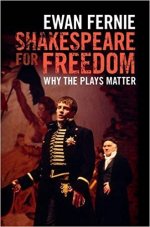Shakespeare for Freedom: Why the Plays Matter by Ewan Fernie
Cambridge University Press, $47.62 hardcover, 300 pages, 1107130859
Professor Ewan Fernie of the Shakespeare Institute explores how the Bard’s writing relates to socio-political and personal notions of liberty in his new book, Shakespeare for Freedom.
Writing in academic prose that’s not overly dense or too hard to digest, Fernie explains that both as an author and as a symbol, Shakespeare invites us to consider, broadly, existential freedom; the freedom to be different or of becoming; and the freedom to enter evil. Pairing close readings of texts like Romeo and Juliet and Henry IV Part I with analysis of literary criticism from the likes of Hegel, Freud, and Adorno, among others, Fernie puts forward his case for that tripartite Shakespearean freedom inherent in the plays. Further, he looks at how Shakespeare has inspired various political movements and figures fighting for liberty throughout history, from the days when actor David Garrick first politicized the Bard’s legacy with the Shakespeare Jubilee in Stratford in 1769, and later by Hungarian revolutionary Lajos Kossuth in the eighteenth century, up to the late twentieth century, when Nelson Mandela read Shakespeare’s works along with fellow political prisoners at Robben Island. Fernie also includes an investigation of more sinister iterations of Shakespearean freedom, used as a justification by the likes of John Wilkes Booth, himself the son of a Shakespeare actor, for example. Fernie concludes with an interesting discussion of several critical approaches to King Lear, and demonstrates Shakespeare’s ultimate call to human understanding and autonomy even in the bleakest of circumstances or on the stormiest of heaths.
While I found the book revealed new layers of meaning to Shakespeare’s work, and the real-world consequences that have unfolded in light of it, I think it may have benefited from some structural changes. Chapters providing close readings of text came after explorations of the political ramifications of reading Shakespeare’s work, and theory was interspersed throughout. I wonder if it would have been a more fluid reading experience to begin with laying out close readings of the text, followed by a critical framework (or vice versa), and then a discussion of Shakespeare in the political realm.
Nevertheless, my experience with the text was largely positive. In particular, I enjoyed the chapter concerning Romeo and Juliet. This was the first Shakespeare play I ever saw and got me interested in his work, and Fernie sculpted an analysis that made me consider the play in new ways; especially how the tragedy presents more radical potentialities and characters than we sometimes allow. Fernie’s discussion of this play adds a new dimension to that age-old question of whether human agency or fate guides the characters in Romeo and Juliet, and also presents a vision of liberty latent in some of the side characters’ dialogue.
All in all, I would recommend this book to those trying to see Shakespeare through new lenses, whether socio-political, historical, or critical.

